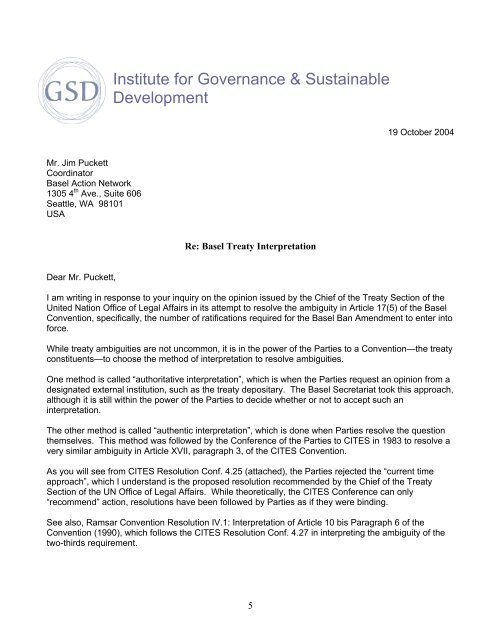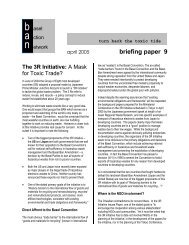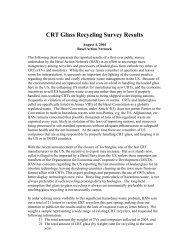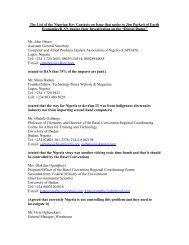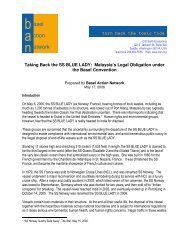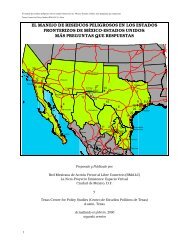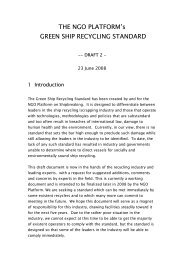Entry into Force of the Basel Ban Amendment - Basel Action Network
Entry into Force of the Basel Ban Amendment - Basel Action Network
Entry into Force of the Basel Ban Amendment - Basel Action Network
Create successful ePaper yourself
Turn your PDF publications into a flip-book with our unique Google optimized e-Paper software.
Mr. Jim Puckett<br />
Coordinator<br />
<strong>Basel</strong> <strong>Action</strong> <strong>Network</strong><br />
1305 4 th Ave., Suite 606<br />
Seattle, WA 98101<br />
USA<br />
Dear Mr. Puckett,<br />
Institute for Governance & Sustainable<br />
Development<br />
Re: <strong>Basel</strong> Treaty Interpretation<br />
5<br />
19 October 2004<br />
I am writing in response to your inquiry on <strong>the</strong> opinion issued by <strong>the</strong> Chief <strong>of</strong> <strong>the</strong> Treaty Section <strong>of</strong> <strong>the</strong><br />
United Nation Office <strong>of</strong> Legal Affairs in its attempt to resolve <strong>the</strong> ambiguity in Article 17(5) <strong>of</strong> <strong>the</strong> <strong>Basel</strong><br />
Convention, specifically, <strong>the</strong> number <strong>of</strong> ratifications required for <strong>the</strong> <strong>Basel</strong> <strong>Ban</strong> <strong>Amendment</strong> to enter <strong>into</strong><br />
force.<br />
While treaty ambiguities are not uncommon, it is in <strong>the</strong> power <strong>of</strong> <strong>the</strong> Parties to a Convention—<strong>the</strong> treaty<br />
constituents—to choose <strong>the</strong> method <strong>of</strong> interpretation to resolve ambiguities.<br />
One method is called “authoritative interpretation”, which is when <strong>the</strong> Parties request an opinion from a<br />
designated external institution, such as <strong>the</strong> treaty depositary. The <strong>Basel</strong> Secretariat took this approach,<br />
although it is still within <strong>the</strong> power <strong>of</strong> <strong>the</strong> Parties to decide whe<strong>the</strong>r or not to accept such an<br />
interpretation.<br />
The o<strong>the</strong>r method is called “au<strong>the</strong>ntic interpretation”, which is done when Parties resolve <strong>the</strong> question<br />
<strong>the</strong>mselves. This method was followed by <strong>the</strong> Conference <strong>of</strong> <strong>the</strong> Parties to CITES in 1983 to resolve a<br />
very similar ambiguity in Article XVII, paragraph 3, <strong>of</strong> <strong>the</strong> CITES Convention.<br />
As you will see from CITES Resolution Conf. 4.25 (attached), <strong>the</strong> Parties rejected <strong>the</strong> “current time<br />
approach”, which I understand is <strong>the</strong> proposed resolution recommended by <strong>the</strong> Chief <strong>of</strong> <strong>the</strong> Treaty<br />
Section <strong>of</strong> <strong>the</strong> UN Office <strong>of</strong> Legal Affairs. While <strong>the</strong>oretically, <strong>the</strong> CITES Conference can only<br />
“recommend” action, resolutions have been followed by Parties as if <strong>the</strong>y were binding.<br />
See also, Ramsar Convention Resolution IV.1: Interpretation <strong>of</strong> Article 10 bis Paragraph 6 <strong>of</strong> <strong>the</strong><br />
Convention (1990), which follows <strong>the</strong> CITES Resolution Conf. 4.27 in interpreting <strong>the</strong> ambiguity <strong>of</strong> <strong>the</strong><br />
two-thirds requirement.


